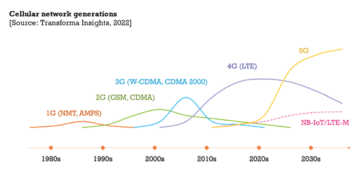
Orange has announced that it has reached a major milestone on its journey towards software and data based, fully-automated networks, with the results of its end-to-end cloud-native 5G SA experimental multi-cloud network, named Pikeo. This experimental network, the first of its kind in Europe at the time of its launch in June 2021, represents a key stage in its preparation and underlines Orange’s leadership in determining the shape of future networks. The experiment has run over two locations in France to date and is currently used by internal employees. The trial will be extended soon to a third site in Spain for internal use.
Deploying 5G private networks on cloud environments creates new opportunities for cases like smart factories removing boundaries between network connectivity and digital applications. The Pikeo 5G SA network is multi-cloud and is deployed:
either on an on-premises Orange Telco Cloud infrastructure, operated by Orange, and leveraging the SUSE/Rancher opensource kubernetes distribution. This implementation was instrumental to the contribution to the first beta release of Sylva (the Linux Foundation’s telco cloud solution).
on AWS or using a hybrid architecture with AWS: the core network is deployed in an AWS Region completely or with an optional local AWS Outposts to be consistent with Orange Innovation locations for user traffic control. The second option allows enterprise customers to benefit from low latency or security and local requirements.
Orange’s software and data based telco vision will transform its activities, shaping how it builds, deploys, and operates its future networks. Automation, disaggregation, cloud, data/AI will all play a key role on this journey delivering networks that will operate much faster (for example, deployment 300 times faster; detection of anomalies, 100 times faster; and immediate security updates, when required). The implementation and operation of this greenfield network for more than one year has provided Orange with invaluable experience and knowledge on the automation of cloud native 5G SA networks. The experiment also developed Orange’s know-how in integrating technologies from various partners such as Dell Technologies, AWS, Casa Systems and Hewlett Packard Enterprise, as well as Amdocs, Arista, Mavenir and Xiaomi and clarified what this means in terms of skills and transformation.
Furthermore, this experience has allowed Orange to demonstrate the growing maturity of Open RAN technologies, paving the way for field deployments in the coming years. As an example, the launch of the first field trial in a rural area in Romania last week demonstrates Orange’s confidence that Open RAN is now ready for initial deployments on operational networks.
Leveraging automation and artificial intelligence, Orange’s experimental network demonstrated that:
the 5G network (core and RAN) can be automatically redeployed in less than one hour, rather than days or weeks, as it does on a legacy network, thanks to the implementation of a DevSecOps pipeline.
- automated anomaly detection for mobile networks is much faster. Operational teams have access via a dashboard to automated explainable anomaly detection leveraging artificial intelligence to reduce the Mean Time to Detect (MTTD) an anomaly and to help them identify its root cause by correlating RAN, core and infrastructure metrics.
- energy consumption can be optimised by automatically switching off the 5G private network of a company or facility in the evening and switching on in the morning, which can be particularly relevant for some companies.
- dynamic end-to-end slice management for critical communication services was modelled and demonstrated on the 5G SA core network with isolation, using security and traffic prioritisation principles.
A zero-trust security model was implemented with identity and access management leveraging Orange identity, automated vulnerability detection and integration with SIEM (Security Incidents & Event management).
In parallel, since mid-2022, Orange has worked with Amazon Web Services (AWS) to demonstrate the feasibility to run network functions over a public cloud. This marks a key point in the maturity of how Orange and hyperscalers can work together to deliver compelling solutions to enterprise customers, insisting on two key elements: a Zero Trust security model using Orange identities and Amazon IAM (Identity and Access Management); optimising energy efficiency with an on-demand use of AWS resources cloud infrastructure. The trial is extended in 2023 to further investigate the potential of automation through AI, as well as to evaluate vertical use cases.
Laurent Leboucher, Orange Group CTO and SVP Orange Innovation Networks, says, “We are proud to showcase the benefits of a fully automated cloud native multi-cloud 5G SA network at this year’s Mobile World Congress. The experience gained from the Pikeo project and the expertise of Orange Innovation teams will be leveraged in the new Mobile Private Network cloud experimental offer launched by Orange Business. As Orange seeks to fulfil its ambition to become the telecom reference for resilient, green, software and data-based networks, the results of this trial to date mark a major milestone in achieving this.”
Comment on this article below or via Twitter: @IoTNow_OR @jcIoTnow
- SEO Powered Content & PR Distribution. Get Amplified Today.
- Platoblockchain. Web3 Metaverse Intelligence. Knowledge Amplified. Access Here.
- Source: https://www.iot-now.com/2023/03/01/128298-orange-unveils-results-of-experimental-end-to-end-5g-stand-alone-sa-network-pikeo/
- 100
- 2021
- 2023
- 5G
- 5g network
- a
- access
- access management
- achieving
- activities
- AI
- All
- allows
- alone
- Amazon
- ambition
- and
- and infrastructure
- announced
- anomaly detection
- applications
- architecture
- AREA
- article
- artificial
- artificial intelligence
- Automated
- automatically
- Automation
- AWS
- based
- become
- below
- benefit
- benefits
- beta
- between
- boundaries
- builds
- business
- Casa
- cases
- Cause
- Cloud
- cloud infrastructure
- cloud native
- coming
- Communication
- Companies
- company
- compelling
- completely
- confidence
- Congress
- Connectivity
- consistent
- consumption
- contribution
- control
- Core
- correlating
- creates
- critical
- CTO
- Currently
- Customers
- dashboard
- data
- Date
- Days
- deliver
- delivering
- demonstrate
- demonstrated
- demonstrates
- deployed
- deployment
- deployments
- deploys
- Detection
- determining
- developed
- digital
- distribution
- efficiency
- elements
- employees
- end-to-end
- energy
- energy efficiency
- Enterprise
- enterprise customers
- environments
- Ether (ETH)
- Europe
- evaluate
- evening
- Event
- example
- experience
- experiment
- expertise
- Facility
- factories
- faster
- field
- First
- France
- from
- fully
- functions
- further
- future
- Green
- greenfield
- Group
- Growing
- help
- How
- HTTPS
- Hybrid
- IAM
- identify
- identities
- Identity
- identity and access management
- immediate
- implementation
- implemented
- in
- Infrastructure
- initial
- Innovation
- instrumental
- Integrating
- integration
- Intelligence
- internal
- invaluable
- investigate
- isolation
- IT
- journey
- Key
- Kind
- knowledge
- Kubernetes
- Last
- Latency
- launch
- launched
- Leadership
- Legacy
- leveraging
- linux
- local
- locations
- Low
- major
- management
- mark
- maturity
- means
- Metrics
- milestone
- Mobile
- mobile networks
- Mobile World Congress
- model
- more
- morning
- Named
- native
- network
- networks
- New
- offer
- ONE
- open
- operate
- operated
- operates
- operation
- operational
- opportunities
- Optimised
- Option
- Orange
- Parallel
- particularly
- partners
- Paving
- pipeline
- plato
- Plato Data Intelligence
- PlatoData
- Play
- Point
- potential
- principles
- private
- project
- proud
- provided
- public
- Public cloud
- reached
- ready
- reduce
- region
- release
- relevant
- removing
- represents
- required
- Requirements
- resilient
- Resources
- Results
- Role
- Romania
- root
- Run
- Rural
- SA
- says
- Second
- security
- security updates
- Seeks
- Services
- Shape
- shaping
- showcase
- since
- site
- skills
- Slice
- smart
- Software
- solution
- Solutions
- some
- Soon
- Spain
- Stage
- stand
- such
- teams
- Technologies
- Telco
- telecom
- terms
- The
- Third
- Through
- time
- times
- to
- together
- towards
- traffic
- Transform
- Transformation
- trial
- Trust
- Unveils
- Updates
- use
- User
- various
- via
- vision
- vulnerability
- web
- web services
- week
- Weeks
- What
- which
- will
- Work
- work together
- worked
- world
- year
- years
- zephyrnet
- zero
- zero trust












